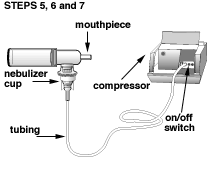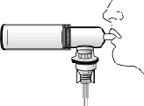Hand-held nebulizers deliver medicines in the form of aerosols to add moisture and help control your respiratory symptoms. Nebulizers use compressors and require electrical outlets to run.
A nebulizer changes liquid medicine into fine droplets (in aerosol or mist form) that are inhaled through a mouthpiece or mask. Nebulizers can be used to deliver many types of medicines. The medicines and moisture help control breathing problems like wheezing and help loosen lung secretions.
A nebulizer might be used instead of other inhalers. A nebulizer is powered by an air compressor that plugs into an electrical outlet.
Cleveland Clinic is a non-profit academic medical center. Advertising on our site helps support our mission. We do not endorse non-Cleveland Clinic products or services. Policy
You will need the following supplies:
Use the nebulizer in a well-lighted area. Select a comfortable place in your home where you can take your treatment without being interrupted. Sit in a comfortable, straight-backed chair when taking your treatment.
Treatment procedure




Care of nebulizer
Cleaning and disinfecting your equipment is simple, yet very important. After each treatment, rinse the nebulizer cup with warm water. Shake off excess water and let it air dry.
At the end of each day, the nebulizer cup, mask, or mouthpiece should be washed in warm, soapy water using a mild detergent. Rinse thoroughly, and allow to air dry. Note: There is no need to clean the tubing that connects the nebulizer to the air compressor.
Disinfect your nebulizer once per week or more frequently as directed. After washing your equipment, disinfect the nebulizer with one of the following methods.
Disposable nebulizers should use one of these cold disinfecting methods:
After any of these cold disinfecting techniques, rinse well and air dry.
Non-disposable nebulizers may be disinfected as described above. They may also be disinfected by any of the following heat disinfecting methods:
Medicine storage
Store all of your medicines in a cool, dry place, and follow the manufacturer’s recommendations.
Check your medicines often. Make sure they have not changed color or formed crystals. If you notice any changes in the appearance of your medicines, throw them away.
Compressor care
You can download A Patient's Guide to Aerosol Drug Delivery from the American Association for Respiratory Care.
Last reviewed by a Cleveland Clinic medical professional on 11/20/2019.
Learn more about our editorial process.
Cleveland Clinic is a non-profit academic medical center. Advertising on our site helps support our mission. We do not endorse non-Cleveland Clinic products or services. Policy